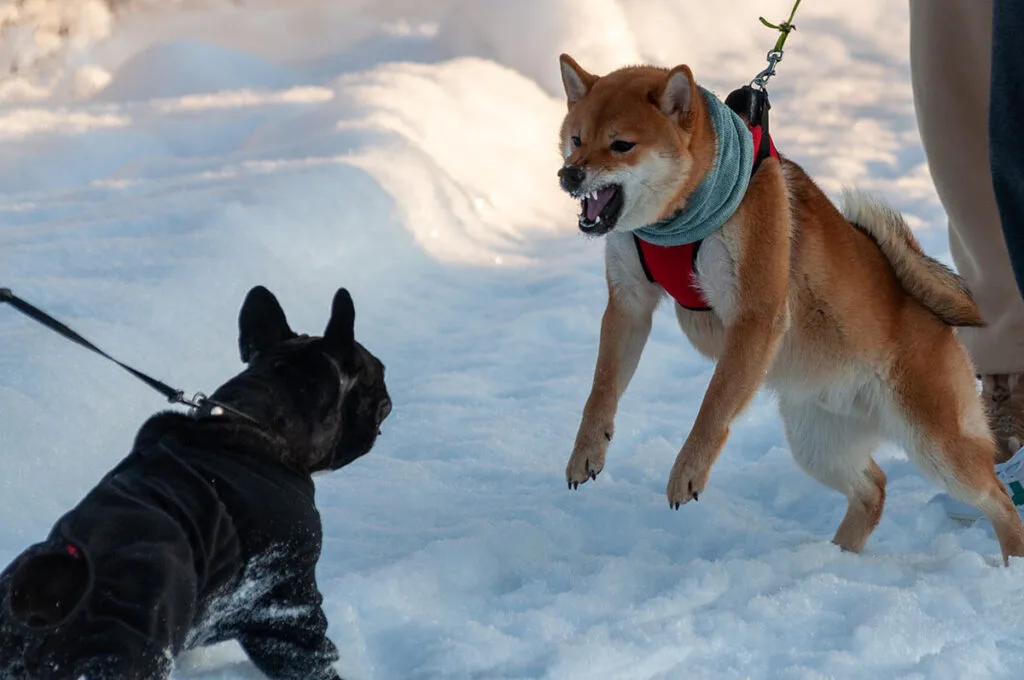Walking a dog who lunges, barks, or pulls can be overwhelming, and it’s not what most of us imagined when we brought a dog into our lives. I bet you pictured the perfect dog that calmly strolled by your side, happily greeted neighbors with a wagging tail, and trotted past squirrels and people on bicycles without a second glance.
In reality, for many of us with a reactive dog, the walk feels more like a tactical mission than a relaxing outing. One unexpected noise, movement, or sight can send your dog into a barking, lunging frenzy, and leave you feeling stressed, embarrassed, or defeated.
Surprisingly, what I didn’t expect when I started this journey was just how much dog behavior could complicate something as simple and essential as going for a walk.
Why I Got a Dog - and What I Didn't Expect
As an introvert and self-declared couch potato, I needed motivation to get outside and reconnect with the world beyond my front door. That motivation came with four paws and a tail.
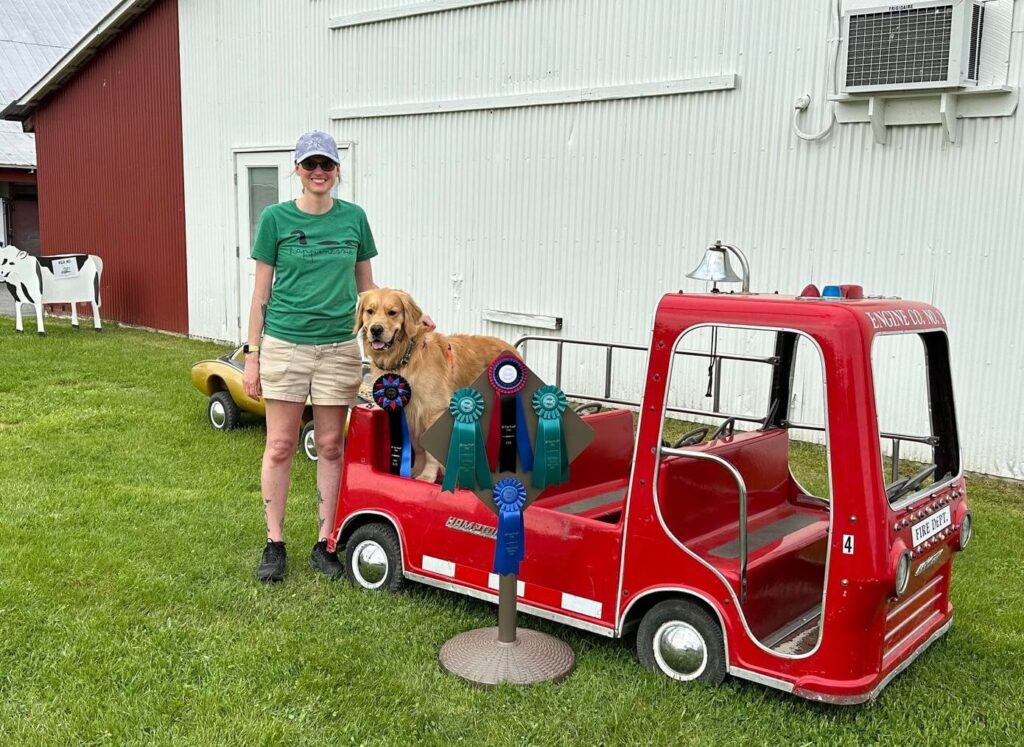
I had always admired people who seemed effortlessly active with their dogs, walking through parks, visiting local cafes with a pup in tow. I craved that lifestyle, the idea of having a reason to step out into the world more regularly, with purpose.
Fisher, my current dog, is a 3.5-year-old golden retriever and the perfect walking companion. Calm, steady, and confident, he loves exploring, whether it’s a walk around the neighborhood, a trail hike, a trip to the store, or a nosework trial where we compete against other teams.
These experiences take us into public spaces full of activity and distractions: other dogs, vehicles, wildlife, unfamiliar people, and he navigates them with calm confidence and an ease that still impresses me.
Meeting his daily needs also meets my own: physical movement, mental clarity, and emotional connection. There’s something powerful about simply being outside. Exposure to sunlight, a change in environment, and fresh air can significantly boost mood and reduce stress. For people, especially those who work from home or tend to isolate, even a short walk can create a meaningful shift in perspective. Even when I don’t feel like it, we head out the door, and I never regret it.
Before Fisher: Life With a Dog Who Struggled With the World
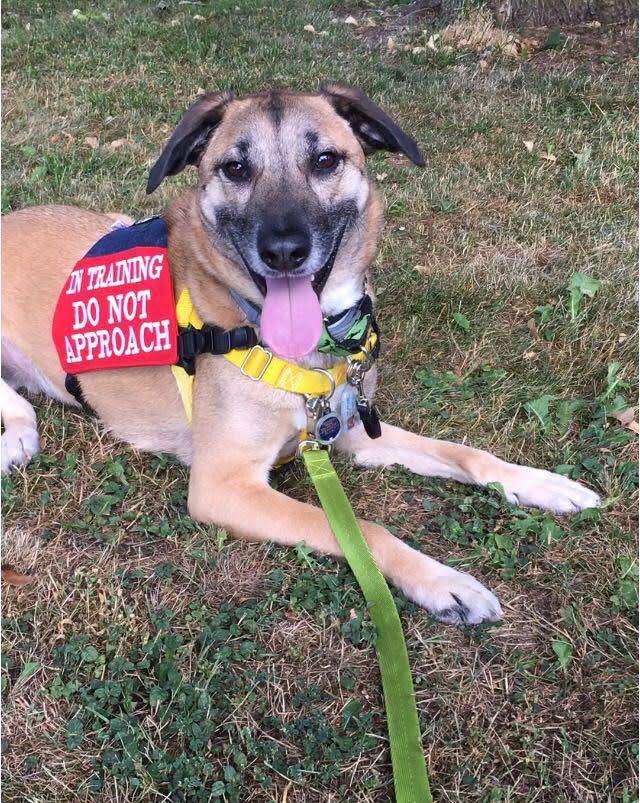
Cooper joined our family in 2012. Going anywhere with Cooper took careful planning. It wasn’t just walks, it was everything. A trip to the vet. A car ride. Even loading him into the vehicle meant managing a dozen variables. We avoided busy times of day, memorized which houses had dogs we needed to steer clear of, and always had a backup escape route planned. We mostly stuck to our neighborhood and rerouted constantly to avoid stressful encounters.
For example, one moment stands out: I remember circling back home because the neighbor’s dog, who was usually inside by that time of day, was still out. I was exhausted. I felt like I was the only person going through this.
These days, I know better. Most of the dogs I work with are leash reactive: they lunge at dogs, people, or sudden movement. Knowing that doesn’t erase how hard it was, but it brings perspective. With time, support, and the right strategies, Cooper began to feel safer in the world. And I began to trust myself to guide him through it.
What I See Now as a Dog Behavior Consultant
When Cooper was alive, I was still taking electives in college and trying to figure out what direction to take. I hadn’t planned to work with dogs; I just wanted to help mine. So I dove into every book, webinar, and article I could find about dog obedience, dog behavior, and training. The deeper I went, the more fascinated I became. That curiosity led me to pursue a Bachelor’s Degree in Psychology, where I could combine my interest in behavioral science with my personal experiences.
Fast forward to 2025. Walking Fisher gives me the space to reflect on what I used to miss. I didn’t see the silent struggles of other dog owners with leash-reactive dogs. People doing their best with dogs who were just as sensitive and overwhelmed as mine once was. I recognize that look now, because I carried it too.
Now I see the dogs barking at passing cyclists, freezing in doorways, or lunging toward distractions. I see the people beside them scanning the street, gripping the leash a little tighter, lowering their voices, and hoping things don’t spiral. I’ve been there.
As a Certified Dog Behavior Consultant, I now support other dog-and-human teams through the same emotional and behavioral challenges I once faced. My goal is never perfection. It’s to help people feel more prepared, more hopeful, and more connected. And just as importantly, I help dogs change how they feel about the world. Sometimes the most powerful thing we need isn’t a flawless walk. It’s knowing someone truly understands what we’re going through and how to help both ends of the leash move forward.
Understanding Why Dogs Lunge in Public
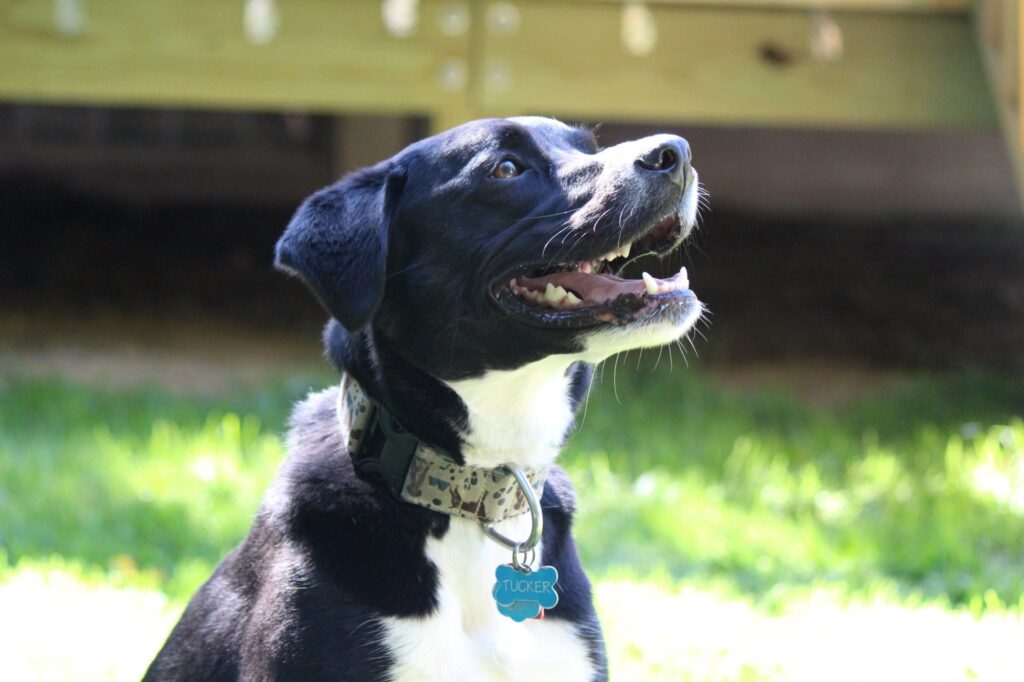
Lunging doesn’t mean a dog is aggressive, dominant, or bad. More often, it’s a sign of stress, fear, or overstimulation. Many reactive dogs are simply overwhelmed by the sights, sounds, and unpredictability of the world around them. In those moments, lunging is a form of communication. It is a desperate attempt to create space, feel safer, or regain control.
Some dogs are triggered by head-on greetings with other dogs. Others react to fast-moving objects, such as bikes, skateboards, or joggers. Sudden sounds, such as garbage trucks, car horns, or even rustling wind, can push a sensitive dog past their threshold. The problem isn’t just the trigger; it’s how that moment makes the dog feel.
This type of leash reactivity is one of the most common challenges I see in my work with clients. And while every dog is different, the emotional toll it takes on both ends of the leash is a familiar one. A dog’s big reaction in public often leads to harsh judgment not just of the dog, but of the person holding the leash.
But change is possible, even for a dog who lunges at every distraction. With the right training plan, even the most reactive dogs can learn to feel differently. If you’ve ever wondered whether change is possible, you’re not alone. You can actually see this kind of progress in a before-and-after video compilation.
From Barking to Breakthroughs: Vivee’s Journey
One of the most memorable transformations I’ve witnessed is Vivee’s. A sharp and sensitive Miniature Schnauzer with a deep desire to work, Vivee found the outside world challenging.
Just going for a walk was often overwhelming, as many people in the surrounding communities have dogs. Shelly and Vivee would hear dogs barking from the windows as they walked by various houses. Even though Vivee couldn’t see them, their barks were enough to put her on edge.
Along a stretch of one of their walking routes, Shelly and Vivee often crossed paths with Ollie, the easy-going Labrador everyone seemed to know. Vivee detected him from hundreds of yards away; her muscles tensed, barking erupted, and each step closer magnified the frenzy. Shelly would guide Vivee to the opposite side of the street, shove treats into her mouth, and hope for the best.
Occasionally, they slipped by with only a brief outburst, but most walks ended in a full-blown scene that Shelly eventually recorded on video.
A Turning Point: Enrolling in Training
They joined our Elite Training Program, designed to change dogs’ behavior by addressing their underlying emotions. Shelly was thrilled when Vivee progressed to the point where she could walk out the door without noticing the neighbor dogs barking, and could stop in front of Ollie’s house to chat with her owner, who Vivee also found intimidating.
Shelly enrolled in online nosework classes to boost Vivee’s confidence. In-person classes once felt out of reach. But gradually, the lunging stopped. Vivee’s emotions shifted. Her behavior followed.
Shelly enrolled in online nosework classes as a way to boost Vivee’s confidence and further their bond. There was no way Vivee could handle in-person classes, and competing in the sport wasn’t something that Shelly thought they could ever do.
But gradually, the lunging stopped. Vivee’s emotions shifted, and her behavior followed. We added to Vivee’s training plan to incorporate new goals. Then the previously unattainable happened: Vivee started attending in-person classes.
Vivee wasn’t just “holding it together.” She was calm, focused, and responsive, even with other dogs nearby. And Shelly is too, knowing that they have the skills to handle whatever comes their way.
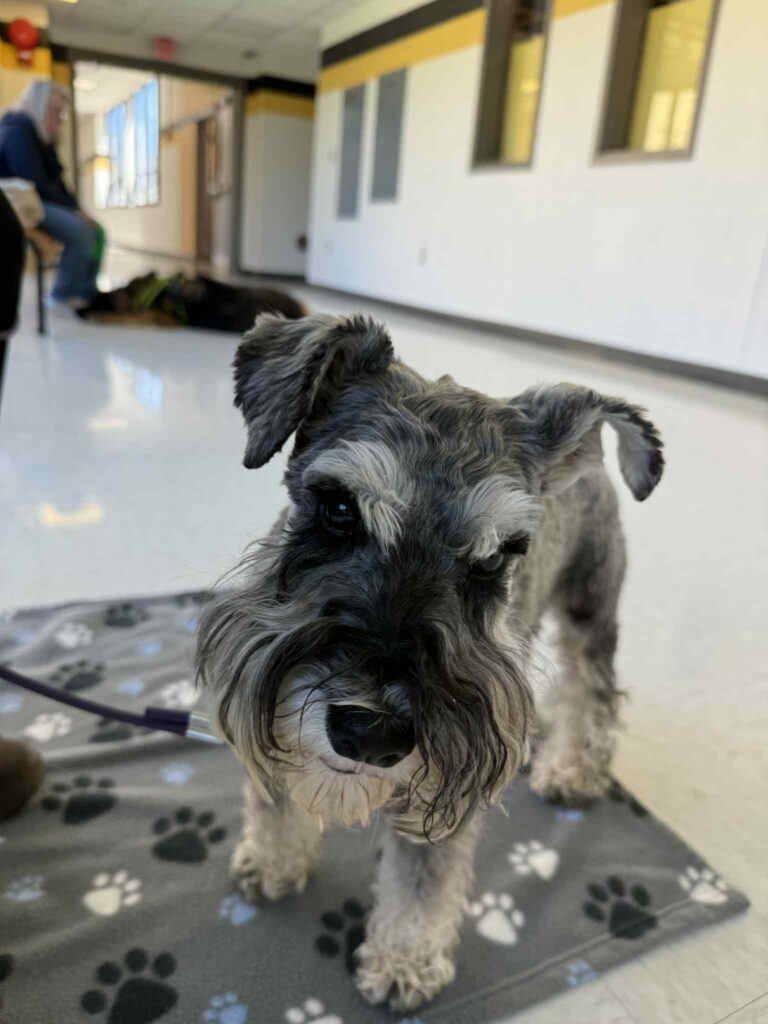
One day, after class, Shelly sent me a message with a photo of Vivee waiting for her turn, with a dog stationed behind her. Shelly wrote:
“That actually felt fun. I didn’t think we’d ever get to this point.”
Want to see the difference training makes? In the clip below, Vivee is calmly waiting in her crate during a busy group nose-work class while other dogs bark in the background. This is a level of relaxation that was once impossible.
Going From Practice to Competition
And yet, they have achieved even more. Vivee has successfully competed in multiple nosework trials.
Take a look at her in this video clip. The pressures of strangers, dogs waiting their turn, and the overall trial environment have melted away.
If you listen closely, you will hear a dog bark at 58 seconds, and then Vivee checks in with Shelly. Vivee gets back to work, and just 17 seconds later, she successfully finds the hide! And the judge you hear saying “yes” after Shelly calls “alert”: Vivee used to be afraid of him.
Why Stories Like Vivee's Matter
Vivee’s story isn’t unique for the dogs that I work with, but it is powerful. What made the difference wasn’t luck. It was strategy, support, and structure. And if you’re reading this, wondering if things could ever feel easier with your dog, the answer is YES.
Check out these Facebook and Google reviews from our clients to see the changes that are possible.
Real change begins with understanding how your dog experiences the world, and how to help them feel safer in it.
FAQ: Understanding Leash Reactivity in Public Spaces
Lunging is often a sign of overstimulation, fear, or stress. Your dog may be trying to create space or cope with uncertainty.
Yes. With the right support. Just take a look at the before-and-after video of some dogs I worked with.
Not necessarily. Many reactive dogs are not aggressive; they’re often just struggling to manage big feelings. Reactivity is a communication of discomfort, not intent to harm. That said, a dog who is repeatedly overwhelmed or unsupported in those moments may escalate to biting or injuring another animal or person. Understanding and addressing the cause early is crucial for ensuring safety and promoting long-term behavior change.
Avoid yelling, jerking the leash, or punishing your dog. These reactions may temporarily suppress the behavior in the moment, but worsen its reactivity over time. Remember, your dog isn’t trying to give you a hard time. They’re having a hard time.
Immediately get out of the situation. Creating distance from the trigger is the best thing you can do in the moment. Your dog isn’t in the right frame of mind to learn. Focus on safety first. There will be time for training later.
Reach out to a qualified dog behavior consultant, like me, for personalized support by filling out this contact form and sharing a little about your dog. I will be in touch to discuss your dog’s behavior and schedule a 30-minute consultation.

